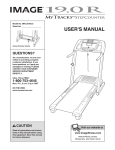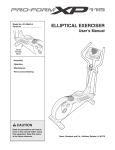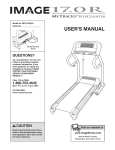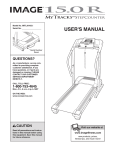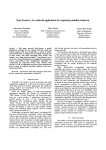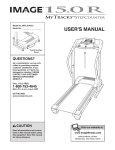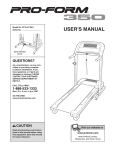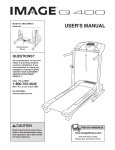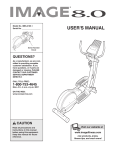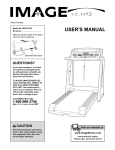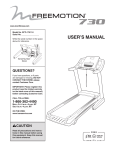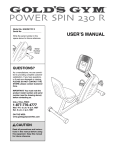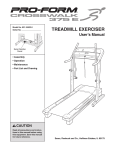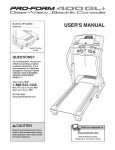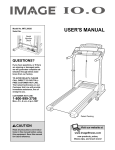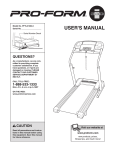Download USER`S MANUAL - Pdfstream.manualsonline.com
Transcript
Model No. IMTL59105.1 Serial No. USER'S MANUAL Serial Number Decal QUESTIONS? As a manufacturer, we are committed to providing complete customer satisfaction. If you have questions, or if parts are damaged or missing, PLEASE CONTACT OUR CUSTOMER SERVICE DEPARTMENT DIRECTLY. CALL TOLL-FREE: 1-800-753-4645 Mon.–Fri., 6 a.m.–6 p.m. MST ON THE WEB: www.iconservice.com CAUTION Read all precautions and instructions in this manual before using this equipment. Save this manual for future reference. Visit our website at www.imagefitness.com new products, prizes, fitness tips, and much more! TABLE OF CONTENTS IMPORTANT PRECAUTIONS . . . . . . . . . . . . . . . . . . . . . . . . . . . . . . . . . . . . . . . . . . . . . . . . . . . . . . . . . . . . . . . .3 BEFORE YOU BEGIN . . . . . . . . . . . . . . . . . . . . . . . . . . . . . . . . . . . . . . . . . . . . . . . . . . . . . . . . . . . . . . . . . . . . . .5 ASSEMBLY . . . . . . . . . . . . . . . . . . . . . . . . . . . . . . . . . . . . . . . . . . . . . . . . . . . . . . . . . . . . . . . . . . . . . . . . . . . . . . .6 HOW TO USE THE CHEST PULSE SENSOR . . . . . . . . . . . . . . . . . . . . . . . . . . . . . . . . . . . . . . . . . . . . . . . . . . .10 OPERATION AND ADJUSTMENT . . . . . . . . . . . . . . . . . . . . . . . . . . . . . . . . . . . . . . . . . . . . . . . . . . . . . . . . . . . .11 HOW TO FOLD AND MOVE THE TREADMILL . . . . . . . . . . . . . . . . . . . . . . . . . . . . . . . . . . . . . . . . . . . . . . . . . .20 TROUBLESHOOTING . . . . . . . . . . . . . . . . . . . . . . . . . . . . . . . . . . . . . . . . . . . . . . . . . . . . . . . . . . . . . . . . . . . . .22 CONDITIONING GUIDELINES . . . . . . . . . . . . . . . . . . . . . . . . . . . . . . . . . . . . . . . . . . . . . . . . . . . . . . . . . . . . . . .25 PART LIST . . . . . . . . . . . . . . . . . . . . . . . . . . . . . . . . . . . . . . . . . . . . . . . . . . . . . . . . . . . . . . . . . . . . . . . . . . . . . .27 ORDERING REPLACEMENT PARTS . . . . . . . . . . . . . . . . . . . . . . . . . . . . . . . . . . . . . . . . . . . . . . . . . .Back Cover LIMITED WARRANTY . . . . . . . . . . . . . . . . . . . . . . . . . . . . . . . . . . . . . . . . . . . . . . . . . . . . . . . . . . . . . .Back Cover Note: An EXPLODED DRAWING is attached in the center of this manual. IMAGE is a registered trademark of ICON IP, Inc. 2 IMPORTANT PRECAUTIONS WARNING: To reduce the risk of burns, fire, electric shock, or injury to persons, read the following important precautions and information before operating the treadmill. 1. It is the responsibility of the owner to ensure that all users of this treadmill are adequately informed of all warnings and precautions. on page 11. To purchase a surge suppressor, see your local IMAGE dealer or call the tollfree telephone number on the front cover of this manual and order part number 146148, or see your local electronics store. 2. Use the treadmill only as described. 3. Place the treadmill on a level surface, with at least eight feet of clearance behind it and two feet on each side. Do not place the treadmill on any surface that blocks air openings. To protect the floor or carpet from damage, place a mat under the treadmill. 12. Failure to use a properly functioning surge suppressor could result in damage to the control system of the treadmill. If the control system is damaged, the walking belt may change speed, accelerate, or stop unexpectedly, which may result in a fall and serious injury. 4. Keep the treadmill indoors, away from moisture and dust. Do not put the treadmill in a garage or covered patio, or near water. 13. Keep the power cord and the surge suppressor away from heated surfaces. 14. Never move the walking belt while the power is turned off. Do not operate the treadmill if the power cord or plug is damaged, or if the treadmill is not working properly. (See TROUBLESHOOTING on page 22 if the treadmill is not working properly.) 5. Do not operate the treadmill where aerosol products are used or where oxygen is being administered. 6. Keep children under the age of 12 and pets away from the treadmill at all times. 15. Read, understand, and test the emergency stop procedure before using the treadmill (see OPERATION AND ADJUSTMENT on page 11). 7. The treadmill should be used only by persons weighing 300 pounds or less. 8. Never allow more than one person on the treadmill at a time. 16. Never start the treadmill while you are standing on the walking belt. Always hold the handrails while using the treadmill. 9. Wear appropriate exercise clothes when using the treadmill. Do not wear loose clothes that could become caught in the treadmill. Athletic support clothes are recommended for both men and women. Always wear athletic shoes. Never use the treadmill with bare feet, wearing only stockings, or in sandals. 17. The treadmill is capable of high speeds. Adjust the speed in small increments to avoid sudden jumps in speed. 18. The pulse sensors are not medical devices. Various factors, including the user's movement, may affect the accuracy of heart rate readings. The pulse sensors are intended only as exercise aids in determining heart rate trends in general. 10. When connecting the power cord (see page 11), plug the power cord into a surge suppressor (not included) and plug the surge suppressor into a grounded circuit capable of carrying 15 or more amps. No other appliance should be on the same circuit. Do not use an extension cord. 19. Never leave the treadmill unattended while it is running. Always remove the key, unplug the power cord, and switch the reset/off circuit breaker to the off position when the treadmill is not in use. (See the drawing on page 5 for the location of the circuit breaker.) 11. Use only a single-outlet surge suppressor that meets all of the specifications described 3 20. Do not attempt to raise, lower, or move the treadmill until it is properly assembled. (See ASSEMBLY on page 6, and HOW TO FOLD AND MOVE THE TREADMILL on page 20.) You must be able to safely lift 45 pounds (20 kg) to raise, lower, or move the treadmill. 24. DANGER: Always unplug the power cord immediately after use, before cleaning the treadmill, and before performing the maintenance and adjustment procedures described in this manual. Never remove the motor hood unless instructed to do so by an authorized service representative. Servicing other than the procedures in this manual should be performed by an authorized service representative only. 21. When folding or moving the treadmill, make sure that the storage latch is fully closed. 22. Inspect and properly tighten all parts of the treadmill regularly. 25. This treadmill is intended for in-home use only. Do not use this treadmill in a commercial, rental, or institutional setting. 23. Never insert any object into any opening. WARNING: Before beginning this or any exercise program, consult your physician. This is especially important for persons over the age of 35 or persons with pre-existing health problems. Read all instructions before using. ICON assumes no responsibility for personal injury or property damage sustained by or through the use of this product. SAVE THESE INSTRUCTIONS The decals shown here have been placed on the treadmill. If a decal is missing, or if it is not legible, call the toll-free telephone number on the front cover of this manual and order a free replacement decal. Apply the decal in the location shown. Note: The decals are not shown at actual size. 4 BEFORE YOU BEGIN Thank you for selecting the new IMAGE® 19.0 R treadmill. The 19.0 R treadmill offers an impressive array of features designed to help you achieve your fitness goals in the convenience and privacy of your home. And when you’re not exercising, the unique 19.0 R treadmill can be folded up, requiring less than half the floor space of other treadmills. number and serial number before calling. The model number of the treadmill is IMTL59105.1. The serial number can be found on a decal attached to the treadmill (see the front cover of this manual for the location). To avoid a registration fee for any service needed under warranty, you must register the treadmill at www.iconservice.com/registration. For your benefit, read this manual carefully before you use the treadmill. If you have questions after reading this manual, please see the front cover of this manual. To help us assist you, note the product model Before reading further, please review the drawing below and familiarize yourself with the labeled parts. Fan Console Water Bottle Holder (no bottle is included) Handrail Key/Clip Storage Latch Reset/Off Circuit Breaker Upright Power Cord Walking Belt Foot Rail Cushioned Walking Platform for maximum exercise comfort RIGHT SIDE BACK Rear Roller Adjustment Bolts 5 ASSEMBLY To hire an authorized service technician to assemble the treadmill, call toll-free 1-800-445-2480. Assembly requires two persons. Set the treadmill in a cleared area and remove all packing materials. Do not dispose of the packing materials until assembly is completed. Note: The underside of the treadmill walking belt is coated with high-performance lubricant. During shipping, a small amount of lubricant may be transferred to the top of the walking belt or the shipping carton. This is a normal condition and does not affect treadmill performance. If there is lubricant on top of the walking belt, simply wipe off the lubricant with a soft cloth and a mild, non-abrasive cleaner. Assembly requires the included allen wrench cutters , adjustable wrench and your own phillips screwdriver , and rubber mallet . , wire Use the drawings below to identify the hardware used during assembly. Note: If a part is not in the parts bag, check to see if it has been preattached to one of the parts to be assembled. To avoid damaging plastic parts, do not use power tools for assembly. Silver Ground Screw (94)–1 Screw (3)–11 1” Tek Screw (83)–4 Wheel Bolt (81)–2 Handrail Star Washer (89)–4 Upright Star Washer (67)–4 Handrail Bolt (64)–4 Upright Bolt (65)–4 Wheel Spacer (97)–4 Wheel Nut (32)–2 1. Make sure that the power cord is unplugged. 1 With the help of a second person, carefully tip the treadmill onto its left side as shown. Partially fold the Frame (58) so the treadmill is more stable. Do not fully fold the treadmill until it is completely assembled. 58 84 44 83 82 82 Press a Base Endcap (44) into the indicated end of the Upright Base (84). Make sure that the Base Endcap is oriented as shown in the inset drawing. If necessary, use a rubber mallet to insert the Base Endcap. 83 Attach two Base Pads (82) to the Upright Base (84) with two 1” Tek Screws (83). 44 6 84 2. Attach a Wheel (80) and two Wheel Spacers (97) to the Upright Base (84) with a Wheel Bolt (81) and a Wheel Nut (32) as shown. Do not overtighten the Wheel Nut; the Wheel should turn freely. 2 84 81 97 80 32 3. Identify the Right Upright (14). 97 3 Straighten the Upright Wire Harness (77), and feed it into the lower end of the Right Upright (14) and out of the hole shown in the inset drawing. Next, hold the Right Upright against the right side of the Upright Base (84); make sure that the Right Upright is turned so that the upper end is angled in the direction shown. Hand tighten two Upright Bolts (65) with two Upright Star Washers (67) into the Upright Base and the Right Upright; be careful not to damage the Upright Wire Harness. Do not tighten the Upright Bolts yet. 14 77 44 14 82 With the help of a second person, carefully tip the treadmill onto its other side. Attach the other Base Endcap (44) and two Base Pads (82) as described in step 1. Next, attach the other Wheel (80) as described in step 2. Then, attach the Left Upright (not shown) as described above. Note: There is not a wire harness on the left side. 4. With the help of a second person, carefully raise the Uprights (14, 13 [not shown]) to a vertical position. 77 84 65 67 80 82 4 Hold the Handrail (20) near the Right Upright (14). Insert the Upright Wire Harness (77) into the hole in the bottom of the Handrail and out of the top as shown. Next, set the Handrail (20) on the Right Upright (14) and the Left Upright (not shown). Do not let the Upright Wire Harness (77) fall into the Right Upright. Attach the Handrail (20) with four Handrail Bolts (64) (only two are shown) and four Handrail Star Washers (89); start all four Handrail Bolts, slide the Handrail upward, and then firmly tighten the Handrail Bolts. 7 64 89 20 77 89 14 5. While a second person holds the console assembly near the Handrail (20) as shown, attach the ground wire to the indicated hole in the Handrail with a Silver Ground Screw (94). 5 Ground Wire 94 Hole 20 Console Assembly 6. While a second person continues to hold the console assembly, look underneath it and locate the Console Wire Harness (78). 6 Connect the Console Wire Harness (78) to the Upright Wire Harness (77). Make sure to connect the connectors properly (see the inset drawing). The connectors should slide together easily and snap into place. If the connectors do not slide together easily and snap into place, turn one connector and then try again. IF THE CONNECTORS ARE NOT CONNECTED PROPERLY, THE CONSOLE MAY BE DAMAGED WHEN THE POWER IS TURNED ON. Then, insert the Wire Harnesses down into the Handrail (20). 7. Set the console assembly on the Handrail (20). Be careful to avoid pinching any of the wires. Hand tighten five Screws (3) into the Handrail and the console assembly. Do not put Screws into the two indicated holes. Start all five Screws, but do not tighten them yet. 77 78 77 20 7 Console Assembly 20 3 3 No Screws 8 78 Console Assembly 3 8. Hand tighten four additional Screws (3) into the Handrail (20) and the console assembly. Then, tighten all nine Screws used in step 7 and this step; do not overtighten the Screws. 8 Console Assembly 20 3 3 9. Lower the Uprights (13, 14) until the Handrail (20) is touching the floor. 3 9 13, 14 See the lower drawing. Position the Uprights (13, 14) so the Frame (58) is centered between them. 20 See the upper drawing. Firmly tighten the four Upright Bolts (65). Then, raise the Uprights (13, 14) back to the vertical position. 65 Top View 14 13 58 10. Attach the Latch Housing (73) to the Left Upright (13) with two Screws (3); start both Screws and then tighten them. Make sure that the large hole in the Latch Housing is on the indicated side. 10 13 3 Remove the knob from the pin. Make sure that the collar and the spring are on the pin. (Note: If there are two collars, place one on each side of the spring.) Next, insert the pin into the Latch Housing (73). Then, tighten the knob back onto the pin. Before operating the treadmill, plug in the power cord (see page 11), and then lower the treadmill to the lowest incline level (see page 13). Knob 3 Large Hole 73 Spring Collar Pin 11. Make sure that all parts are properly tightened before you use the treadmill. If there are sheets of clear plastic on the treadmill decals, remove the plastic. To protect the floor or carpet, place a mat under the treadmill. Note: Extra hardware may be included. Keep the included allen wrench in a secure place; the large allen wrench is used to adjust the walking belt (see page 23). 9 HOW TO USE THE CHEST PULSE SENSOR HOW TO PUT ON THE CHEST PULSE SENSOR dried. If the chest pulse sensor is not dried after each use, it may remain activated longer than necessary, draining the battery prematurely. The chest pulse sensor consists of two components: the chest strap and the sensor unit (see the drawing below). Insert the tab on one end of the chest strap into one end of the sensor unit, as shown in the inset drawing. Press the end of the sensor unit under the buckle on the chest strap. The tab should be flush with the front of the sensor unit. • Store the chest pulse sensor in a warm, dry place. Do not store the chest pulse sensor in a plastic bag or other container that may trap moisture. • Do not expose the chest pulse sensor to direct sunlight for extended periods of time; do not expose it to temperatures above 122° Fahrenheit (50° Celsius) or below 14° Fahrenheit (-10° Celsius). • Do not excessively bend or stretch the sensor unit when using or storing the chest pulse sensor. Chest Strap Tabs • Clean the sensor unit using a damp cloth—never use alcohol, abrasives, or chemicals. The chest strap may be hand washed and air dried. Tab CHEST PULSE SENSOR TROUBLESHOOTING Sensor Unit Sensor Unit Buckle The instructions on the following pages explain how the chest pulse sensor is used with the console. If the chest pulse sensor does not function properly, try the steps below. Next, wrap the chest pulse sensor around your chest and attach the other end of the chest strap to the sensor unit. Adjust the length of the chest strap, if necessary. The chest pulse sensor should be under your clothes, tight against your skin, and as high under the pectoral muscles or breasts as is comfortable. Make sure that the logo on the sensor unit is facing forward and is right-side-up. • Make sure that you are wearing the chest pulse sensor as described at the left. Note: If the chest pulse sensor does not function when positioned as described, move it slightly lower or higher on your chest. • Use saline solution such as saliva or contact lens solution to wet the two electrode areas on the sensor unit. If heart rate readings do not appear until you begin perspiring, re-wet the electrode areas. • As you walk or run on the treadmill, position yourself near the center of the walking belt. For the console to display heart rate readings, the user must be within arm’s length of the console. Pull the sensor unit away from your body a few inches and locate the two electrode areas on the inner side (the electrode areas are covered by shallow ridges). Using saline solution such as saliva or contact lens solution, wet both electrode areas. Return the sensor unit to a position against your chest. • The chest pulse sensor is designed to work with people who have normal heart rhythms. Heart rate reading problems may be caused by medical conditions such as premature ventricular contractions (pvcs), tachycardia bursts, and arrhythmia. CHEST PULSE SENSOR CARE AND MAINTENANCE • The operation of the chest pulse sensor can be affected by magnetic interference caused by high power lines or other sources. If it is suspected that this is a problem, try relocating the treadmill. • Thoroughly dry the chest pulse sensor after each use. The chest pulse sensor is activated when the electrode areas are wetted and the heart rate monitor is put on; the chest pulse sensor shuts off when it is removed and the electrode areas are • The CR2032 battery may need to be replaced (see page 24). 10 OPERATION AND ADJUSTMENT THE PRE-LUBRICATED WALKING BELT tric shock. This product is equipped with a cord having an equipment-grounding conductor and a grounding plug. Plug the power cord into a surge suppressor, and plug the surge suppressor into an appropriate outlet that is properly installed and grounded in accordance with all local codes and ordinances. Important: The treadmill is not compatible with GFCI-equipped outlets. Your treadmill features a walking belt coated with highperformance lubricant. IMPORTANT: Never apply silicone spray or other substances to the walking belt or the walking platform. Such substances will deteriorate the walking belt and cause excessive wear. HOW TO PLUG IN THE POWER CORD This product is for use on a nominal 120-volt circuit, and has a grounding plug that looks like the plug illustrated in drawing 1 below. A temporary adapter that looks like the adapter illustrated in drawing 2 may be used to connect the surge suppressor to a 2-pole receptacle as shown in drawing 2 if a properly grounded outlet is not available. DANGER: Improper connection of the equipment-grounding conductor can result in an increased risk of electric shock. Check with a qualified electrician or serviceman if you are in doubt as to whether the product is properly grounded. Do not modify the plug provided with the product—if it will not fit the outlet, have a proper outlet installed by a qualified electrician. 1 Grounded Outlet Box Surge Suppressor Grounding Pin Your treadmill, like any other type of sophisticated electronic equipment, can be seriously damaged by sudden voltage changes in your home’s power. Voltage surges, spikes, and noise interference can result from weather conditions or from other appliances being turned on or off. To decrease the possibility of your treadmill being damaged, always use a surge suppressor with your treadmill (see drawing 1 at the right). To purchase a surge suppressor, see your local IMAGE dealer or call the toll-free telephone number on the front cover of this manual and order part number 146148, or see your local electronics store. Grounding Pin Grounded Outlet Grounding Plug 2 Grounded Outlet Box Adapter Use only a single-outlet surge suppressor that is UL 1449 listed as a transient voltage surge suppressor (TVSS). The surge suppressor must have a UL suppressed voltage rating of 400 volts or less and a minimum surge dissipation of 450 joules. The surge suppressor must be electrically rated for 120 volts AC and 15 amps. There must be a monitoring light on the surge suppressor to indicate whether it is functioning properly. Failure to use a properly functioning surge suppressor could result in damage to the control system of the treadmill. If the control system is damaged, the walking belt may change speed, accelerate or stop unexpectedly, which may result in a fall and serious injury. Surge Suppressor Lug Metal Screw The temporary adapter should be used only until a properly grounded outlet (drawing 1) can be installed by a qualified electrician. The green-colored rigid ear, lug, or the like extending from the adapter must be connected to a permanent ground such as a properly grounded outlet box cover. Whenever the adapter is used it must be held in place by a metal screw. Some 2-pole receptacle outlet box covers are not grounded. Contact a qualified electrician to determine if the outlet box cover is grounded before using an adapter. This product must be grounded. If it should malfunction or break down, grounding provides a path of least resistance for electric current to reduce the risk of elec- 11 CONSOLE DIAGRAM Note: If there is a sheet of clear plastic on the face of the console, remove it. Clip Key FEATURES OF THE CONSOLE MyTracks™ StepCounter Program The treadmill console offers a selection of features designed to make your workouts more effective. When the manual mode of the console is selected, the speed and incline of the treadmill can be changed with the touch of a button. As you exercise, the console will display continuous exercise feedback. You can even measure your heart rate using the handgrip pulse sensor or the chest pulse sensor. Walking is one of the most popular exercises worldwide. Walking does not require advanced conditioning or special skills, yet it produces numerous benefits, such as increased calorie burning, a slimmer waist, toned muscles, enhanced energy and stamina, lower blood pressure, and reduced stress. To track your walking exercise, the console offers a MyTracks™ StepCounter program that allows you to enter the number of steps that you plan to walk, and counts down the steps as you exercise. Trainer Programs The console also features six trainer programs. Each trainer program automatically controls the speed and incline of the treadmill as it guides you through an effective workout. More reliable than conventional pedometers, the MyTracks™ StepCounter is highly accurate with most users. For the best results, try to maintain a consistent pace, stride length, and position on the treadmill as you walk. Lighter users may also find it helpful to reduce the incline of the treadmill or to increase the speed of the walking belt. Cardio Control Programs The console also offers two cardio control programs. Each cardio control program adjusts the speed and incline of the treadmill to keep your heart rate near a target heart rate setting during your workouts. To use the manual mode of the console, follow the steps beginning on page 13. To use a trainer program, see page 15. To use a cardio control program, see page 16. To use the MyTracks™ StepCounter program, see page 18. 12 HOW TO TURN ON THE POWER 1 Plug in the power cord (see page 11). 2 Locate the reset/off circuit breaker near the power cord. Make sure that the circuit breaker is in the reset position. 3 walking belt as desired by pressing the Speed increase and decrease buttons. Each time a button is pressed, the speed setting will change by 0.1 mph; if a button is held down, the speed setting will change in increments of 0.5 mph. Note: After the buttons are pressed, it may take a moment for the walking belt to reach the selected speed setting. Reset Position If one of the numbered speed buttons is pressed, the walking belt will gradually change in speed until it reaches the selected speed setting. Next, stand on the foot rails of the treadmill. Find the clip attached to the key (see the drawing on page 12) and slide the clip onto the waistband of your clothes. Then, insert the key into the console. After a moment, the display will light. Important: In an emergency situation, the key can be pulled from the console, causing the walking belt to slow to a stop. Test the clip by carefully taking a few steps backward; if the key is not pulled from the console, adjust the position of the clip. To stop the walking belt, press the Stop button. The time will begin to flash in the display. To restart the walking belt, press the Start button, the Speed increase button, or one of the numbered speed buttons. Note: The first time the treadmill is used, observe the alignment of the walking belt, and center the walking belt if necessary (see page 23). HOW TO USE THE MANUAL MODE 4 1 Insert the key into the console. To change the incline of the treadmill, press the Incline increase and decrease buttons. Each time a button is pressed, the incline will change by 0.5%. Note: After the buttons are pressed, it may take a moment for the treadmill to reach the selected incline setting. See HOW TO TURN ON THE POWER above. 2 Select the manual mode. When the key is inserted, the manual mode will be Track selected. If a program has been selected, reselect the manual mode by pressing the Program Select button repeatedly until a track appears in the display. 3 Change the incline of the treadmill as desired. 5 Follow your progress with the display. When the manual mode is selected, the display will show a Track track that represents 1/4 mile. As you walk or run, the indicators around the track will appear in succession until the entire track appears. The track will then disappear and the indicators will again begin to appear in succession. Start the walking belt. To start the walking belt, press the Start button, the Speed increase button, or one of the speed buttons numbered 1 to 10. If the Start button or the Speed increase button is pressed, the walking belt will begin to move at 1 mph. As you exercise, change the speed of the 13 To measure your heart rate, stand on the foot rails and hold the metal contacts on the handrail—avoid moving your hands. When your pulse is detected, the heart symbol in the right side of the display will begin to flash each time your heart beats, one or two dashes will appear, and then your heart rate will be shown. For the most accurate heart rate reading, continue to hold the contacts for about 15 seconds. The left side of the display will show the elapsed time, the distance that you have walked or run, and the incline level of the treadmill. Note: When a program is selected (except for cardio control program 8), the display will show the time remaining in the program instead of the elapsed time. 7 The right side of the display will show the approximate number of calories you have burned, the speed of the walking belt, and your pace (in minutes per mile). The right side of the display will also show your heart rate when you use the handgrip pulse sensor or the chest pulse sensor. To turn on the fan, press the Fan button. To turn on the fan at high speed, press the button a second time. To turn off the fan, press the button a third time. Note: If the fan is left on when the walking belt is stopped, the fan will automatically turn off after a few minutes. 8 Note: The console can display speed and distance in either miles or kilometers. To find which unit of measurement is selected, hold down the Stop button, insert the key into the console, and then release the Stop button. An “E” for English miles or an “M” for metric kilometers will appear near the lower edge of the display. To change the unit of measurement, press the Speed increase button. When the desired unit of measurement is selected, remove the key. Note: For simplicity, all instructions in this section refer to miles. When you are finished exercising, remove the key. Step onto the foot rails, press the Stop button, and adjust the incline of the treadmill to the lowest setting. The incline must be at the lowest setting when the treadmill is folded to the storage position or the treadmill will be damaged. Next, remove the key from the console and put it in a secure place. Note: If the display remains lit after the key is removed, the console is in the “demo” mode. See page 19 and turn off the demo mode. When you are finished using the treadmill, switch the reset/off circuit breaker to the “off” position and unplug the power cord. To reset the display, press the Stop button, remove the key, and then reinsert the key. 6 Turn on the fan if desired. Measure your heart rate if desired. Note: If you use the handgrip pulse sensor and the chest pulse sensor at the same time, the console will not display your heart rate accurately. Before using the handgrip pulse sensor, remove the sheets of clear plastic from the metal contacts. In addition, make sure that Contacts your hands are clean. 14 tings for the next several segments will be shown in the columns to the right. HOW TO USE A TRAINER PROGRAM 1 When only three seconds remain in the first segment of the program, both the Current Segment column and the column to the right will flash and a series of tones will sound. If the speed and/or incline of the treadmill is about to change, the speed setting and/or the incline setting will flash in the display to alert you. Insert the key into the console. See HOW TO TURN ON THE POWER on page 13. 2 Select one of the trainer programs. To select one of the trainer programs, press the Trainer Programs button repeatedly until “P 1,” “P 2,” “P 3,” “P 4,” “P 5,” or “P 6” appears in the display. When a trainer program is selected, the program time will appear in the display, the maximum incline setting of the program and the maximum speed setting of the program will flash in the display for a few seconds, and a profile of the speed settings of the program will scroll across the matrix in the display. 3 When the first segment is completed, all speed settings will move one column to the left. The speed setting for the second segment will then be shown in the flashing Current Segment column and the treadmill will automatically adjust to the speed and incline settings for the second segment. Note: If all of the indicators in the Current Segment column are lit, the speed settings may move downward so that only the highest indicators appear in the matrix. The program will continue in this way until the speed setting for the last segment is shown in the Current Segment column and the last segment ends. The walking belt will then slow to a stop. If the speed or incline setting for the current segment is too high or too low, you can manually override the setting by pressing the Speed or Incline buttons. Every few times a Speed button is pressed, an additional indicator will appear or disappear in the Current Segment column; if any of the columns to the right of the Current Segment column have the same number of lit indicators as the Current Segment column, an additional indicator may appear or disappear in those columns as well. Important: When the current segment of the program ends, the treadmill will automatically adjust to the speed and incline settings for the next segment. Press the Start button or the Speed increase button to start the program. A moment after the button is pressed, the treadmill will automatically adjust to the first speed and incline settings of the program. Hold the handrails and begin walking. Each program is divided into 30 one-minute segments. One speed setting and one incline setting are programmed for each segment. Note: The same speed setting and/or incline setting may be programmed for two or more consecutive segments. To stop the program at any time, press the Stop button. The time will begin to flash in the display. To restart the program, press the Start button or the Speed increase button. The walking belt will begin to move at 1 mph. When the next segment of the program begins, the treadmill will automatically adjust to the speed and incline settings for the next segment. The speed setting for the first segment will be shown in Current Segment the flashing Current Segment column of the matrix. (The incline settings are not shown in the matrix.) The speed set- 15 4 Follow your progress with the display. See step 5 on page 13. 5 Measure your heart rate if desired. See step 6 on page 14. 6 HOW TO USE A CARDIO CONTROL PROGRAM Cardio control program 7 will automatically adjust the speed and incline of the treadmill to keep your heart rate within a preset range during your workout. Cardio control program 8 will keep your heart rate near a target heart rate setting that you select. Turn on the fan if desired. CAUTION: If you have heart problems, or if you are over 60 years of age and have been inactive, do not use the cardio control programs. If you are taking medication regularly, consult your physician to find whether the medication will affect your exercise heart rate. See step 7 on page 14. 7 When you are finished exercising, remove the key from the console. See step 8 on page 14. Follow the steps below to use a cardio control program. 1 Put on the chest pulse sensor. See page 10. 2 Insert the key into the console. See HOW TO TURN ON THE POWER on page 13. 3 Select a cardio control program. To select a cardio control program, press the Program Select button repeatedly until “P 7” or “P 8” appears in the display. If cardio control program 7 is selected, a profile of the target heart rate settings of the program will scroll across the matrix in the display. If cardio control program 8 is selected, a graphic representing your heartbeat will appear in the matrix. 16 4 the Current Segment column and the column to the right will flash and a series of tones will sound. When the first segment ends, all target heart rate settings will move one column to the left. The target heart rate setting for the second segment will then be shown in the flashing Current Segment column. Enter a target heart rate setting. If cardio control program 7 is selected, the maximum target heart rate setting of the program will appear in the display. If desired, press the increase and decrease buttons beside the Program Select button to change the maximum target heart rate setting (see EXERCISE INTENSITY on page 25). Note: If the maximum target heart rate setting is changed, the intensity level of the entire program will change. During both cardio control programs, the console will regularly compare your heart rate to the current target heart rate setting. If your heart rate is too far below or above the target heart rate setting, the speed of the walking belt will automatically increase or decrease to bring your heart rate closer to the target heart rate setting. If the speed of the walking belt reaches 7.5 mph and your heart rate is still too far below the target heart rate setting, the incline of the treadmill will also increase. If cardio control program 8 is selected, the target heart rate setting for the program will be displayed. If desired, press the increase and decrease buttons beside the Program Select button to change the target heart rate setting (see EXERCISE INTENSITY on page 25). Note: The same target heart rate setting will be programmed for the entire program. 5 If the speed or incline setting is too high or too low at any time during the program, you can adjust the setting with the Speed or Incline buttons. However, each time the console compares your heart rate to the target heart rate setting, the speed and/or incline of the treadmill may automatically change to bring your heart rate closer to the target heart rate setting. Press the Start button or the Speed increase button to start the program. If your pulse is not detected during the program, the letters “PLS” will flash in the display and the speed and/or incline of the treadmill may automatically decrease. If this occurs, see page 10. A moment after the button is pressed, the treadmill will automatically adjust to the first speed and incline settings of the program. Hold the handrails and begin walking. To stop the program at any time, press the Stop button. The time will begin to flash in the display. To restart the program, press the Start button or the Speed increase button. The walking belt will begin to move at 1 mph. When the console compares your heart rate to the target heart rate setting, the speed and/or incline of the treadmill may automatically change to bring your heart rate closer to the target heart rate setting. Cardio control program 7 is divided into 30 oneminute segments. One target heart rate setting is programmed for each segment. (Note: The same target heart rate setting may be programmed for two or more consecutive segments.) Cardio control program 8 is divided into 100 one-minute segments. The same target heart rate setting is programmed for all segments. Note: For a shorter workout, simply stop the program before it ends. 6 If cardio control program 7 is selected, the target heart Current Segment rate setting for the first segment will be shown in the flashing Current Segment column of the matrix. The target heart rate settings for the next several segments will be shown in the columns to the right. When only three seconds remain in the first segment, both Follow your progress with the display. See step 5 on page 13. 7 Turn on the fan if desired. See step 7 on page 14. 8 When you are finished exercising, remove the key from the console. See step 8 on page 14. 17 3 HOW TO USE THE MYTRACKS™ STEP COUNTER PROGRAM 1 A moment after the button is pressed, the walking belt will begin to move at 2 mph. Hold the handrails and begin walking. Insert the key into the console. See HOW TO TURN ON THE POWER on page 13. 2 Press the Start button or the Speed increase button to start the program. As you exercise, adjust the speed and incline of the treadmill as desired by pressing the Speed and Incline buttons. Select the 10,000 steps program. During the program, the display will show the number of steps still to be taken. When only ten steps remain, the display will flash and a tone will sound repeatedly until you reach the goal. The walking belt will then slow to a stop. Press the 10,000 Steps Program button; a goal of 10,000 steps will appear in the display. To stop the program temporarily, press the Stop button. The time will begin to flash in the display. To restart the program, press the Start button or the Speed increase button. The walking belt will begin to move at 2 mph. Depending on your fitness level, you may desire to walk fewer than or more than 10,000 steps. To change the goal, press the increase and decrease buttons beside the 10,000 Steps Program button. Each time a button is pressed, the goal will change by 500 steps. Note: The goal can be changed either before or after the program is started. 4 Follow your progress with the display. See step 5 on page 13. 5 Measure your heart rate if desired. See step 6 on page 14. Note: To find an appropriate starting goal, walk on the treadmill with the manual mode selected (see page 13), and note the number of steps that you walk during your workout. Then, round that number up to the nearest 500 steps. This can be a starting goal. As your fitness level improves, you can increase the goal by 500 steps every few weeks. IMPORTANT: Always exercise at an intensity level and for a length of time that is comfortable for you. 6 Turn on the workout fan if desired. See step 7 on page 14. 7 When the program is completed, remove the key from the console. See step 8 on page 14. 18 THE INFORMATION MODE/DEMO MODE total number of hours that the treadmill has been operated. In addition, an “E” for English miles or an “M” for metric kilometers will appear in the lower part of the display. To change the unit of measurement, press the Speed increase button. The console features an information mode that keeps track of treadmill usage information. The information mode also allows you to select miles or kilometers as the unit of measurement and to turn on and turn off the demo mode. IMPORTANT: If a “d” appears in the display, the console is in the “demo” mode. This mode is intended to be used only when a treadmill is displayed in a store. When the console is in the demo mode, the power cord can be plugged in, the key can be removed from the console, and the indicators in the display will automatically appear in a preset sequence, although the buttons on the console will not operate. If a “d” appears when the information mode is selected, press the Speed decrease button so “d” disappears. To select the information mode, hold down the Stop button, insert the key into the console, and then release the Stop button. When the information mode is selected, the following information will appear in the display: The upper part of the display will show the number of thousands of steps taken by all users of the treadmill. The center of the display will show the total number of miles or kilometers that the walking belt has moved. The lower part of the display will show the To exit the information mode, remove the key from the console. 19 HOW TO FOLD AND MOVE THE TREADMILL HOW TO FOLD THE TREADMILL FOR STORAGE Before folding the treadmill, adjust the incline to the lowest position. If this is not done, the treadmill may be permanently damaged. Next, unplug the power cord. CAUTION: You must be able to safely lift 45 pounds (20 kg) to raise, lower, or move the treadmill. 1. Hold the metal frame firmly in the location shown by the arrow at the right. CAUTION: To decrease the possibility of injury, do not lift the frame by the plastic foot rails. Make sure you bend your legs and keep your back straight. As you raise the frame, make sure to lift with your legs rather than your back. Raise the frame about halfway to the vertical position. Frame 2. Move your right hand to the position shown and hold the treadmill firmly. Using your left hand, pull the latch knob to the left and hold it. Raise the frame until the catch is aligned with the latch pin. Slowly release the latch knob. Make sure that the latch pin is fully inserted into the catch. To protect the floor or carpet from damage, place a mat under the treadmill. Keep the treadmill out of direct sunlight. Do not leave the treadmill in the storage position in temperatures above 85° Fahrenheit. Catch Engaged Latch Knob Latch Pin HOW TO MOVE THE TREADMILL Before moving the treadmill, convert the treadmill to the storage position as described above. Make sure that the latch pin is fully inserted into the catch. 1. Hold the upper ends of the handrails. Place one foot against one of the wheels. 2. Tilt the treadmill back until it rolls freely on the front wheels. Carefully move the treadmill to the desired location. To reduce the risk of injury, use extreme caution while moving the treadmill. Do not move the treadmill over an uneven surface. 3. Place one foot against one of the wheels, and carefully lower the treadmill until it is resting in the storage position. 20 Wheels Base HOW TO LOWER THE TREADMILL FOR USE 1. Hold the upper end of the treadmill with your right hand. Pull the latch knob to the left and hold it. Pivot the frame down until the catch is past the latch pin. Catch Open Latch Knob Latch Pin 2. Hold the metal frame firmly with both hands, and lower the frame to the floor. CAUTION: To decrease the possibility of injury, do not lower the frame by gripping only the plastic foot rails. Do not drop the frame to the floor. Make sure to bend your legs and keep your back straight. Frame 21 TROUBLESHOOTING Most treadmill problems can be solved by following the steps below. Find the symptom that applies, and follow the steps listed. If further assistance is needed, please see the front cover of this manual. PROBLEM: The power does not turn on SOLUTION: a. Make sure that the power cord is plugged into a surge suppressor, and that the surge suppressor is plugged into a properly grounded outlet (see page 11). Use only a single-outlet surge suppressor that meets all of the specifications described on page 11. Important: The treadmill is not compatible with GFCI-equipped outlets. b. After the power cord has been plugged in, make sure that the key is fully inserted into the console. c. Check the reset/off circuit breaker located on the treadmill frame near the power cord. If the switch protrudes as shown, the circuit breaker has tripped. To reset the circuit breaker, wait for five minutes, and then press the switch back in. c Reset Tripped PROBLEM: The power turns off during use SOLUTION: a. Check the reset/off circuit breaker (see the drawing above). If the circuit breaker has tripped, wait for five minutes and then press the switch back in. b. Make sure that the power cord is plugged in. If the power cord is plugged in, unplug it, wait for five minutes, and then plug it back in. c. Remove the key from the console. Reinsert the key into the console. d. If the treadmill still will not run, please see the front cover of this manual. PROBLEM: The incline of the treadmill does not change correctly SOLUTION: a. With the key in the console, press one of the Incline buttons. While the incline is changing, remove the key. After a few seconds, re-insert the key. The treadmill will automatically rise to the maximum incline level and then return to the minimum level. This will recalibrate the incline system. PROBLEM: The display of the console does not function properly SOLUTION: a. Remove the key from the console and UNPLUG THE POWER CORD. With the help of a second person, carefully tip the Uprights (13, 14) down as shown. Next, remove the three Screws (3) and the three Hood Screws (7). Note: A phillips screwdriver with a shaft at least 5” long is required. a 3 7 14 3 13 3 22 With the help of a second person, carefully raise the Uprights (13, 14) to the position shown. Carefully pivot the Hood (41) off. Locate the Reed Switch (63) and the Magnet (46) on the left side of the Pulley (47). Turn the Pulley until the Magnet is aligned with the Reed Switch. Make sure that the gap between the Magnet and the Reed Switch is about 1/8”. If necessary, loosen the Screw (60), move the Reed Switch slightly, and then retighten the Screw. Reattach the Hood, and run the treadmill for a few minutes to check for a correct speed reading. 41 13 Top View 14 1/8” 46 63 60 47 PROBLEM: The walking belt slows when walked on SOLUTION: a. Use only a single-outlet surge suppressor that meets all of the specifications described on page 11. b. If the walking belt is overtightened, treadmill performance may decrease and the walking belt may become damaged. Remove the key and UNPLUG THE POWER CORD. Using the allen wrench, turn both rear roller bolts counterclockwise, 1/4 of a turn. When the walking belt is properly tightened, you should be able to lift each edge of the walking belt 2 to 3 inches off the walking platform. Be careful to keep the walking belt centered. Then, plug in the power cord, insert the key, and run the treadmill for a few minutes. Repeat until the walking belt is properly tightened. b 2”–3” Rear Roller Bolts c. If the walking belt still slows when walked on, please see the front cover of this manual. PROBLEM: The walking belt is off-center or slips when walked on SOLUTION: a. If the walking belt is off-center, remove the key and UNPLUG THE POWER CORD. If the walking belt has shifted to the left, use the allen wrench to turn the left rear roller bolt clockwise 1/2 of a turn; if the walking belt has shifted to the right, turn the left bolt counterclockwise 1/2 of a turn. Be careful not to overtighten the walking belt. Then, plug in the power cord, insert the key, and run the treadmill for a few minutes. Repeat until the walking belt is centered. b. If the walking belt slips when walked on, first remove the key and UNPLUG THE POWER CORD. Using the allen wrench, turn both rear roller bolts clockwise, 1/4 of a turn. When the walking belt is correctly tightened, you should be able to lift each edge of the walking belt 2 to 3 inches off the walking platform. Be careful to keep the walking belt centered. Then, plug in the power cord, insert the key, and carefully walk on the treadmill for a few minutes. Repeat until the walking belt is properly tightened. 23 a b PROBLEM: The chest pulse sensor does not function properly SOLUTION: a. If the chest pulse sensor does not function properly, see CHEST PULSE SENSOR TROUBLESHOOTING on page 10. b. If the chest pulse sensor still does not function properly, the battery should be changed. To replace the battery, locate the battery cover on the back of the sensor unit. Insert a coin into the slot in the cover and turn the cover counterclockwise to the “open” position. Remove the cover. Remove the old battery from the sensor unit. Insert a new CR 2032 battery, making sure that the writing is on top. In addition, make sure that the rubber gasket is in place in the sensor unit. Replace the battery cover and turn it to the closed position. b Battery Cover Battery Cover Battery Rubber Gasket 24 CONDITIONING GUIDELINES WARNING: Before beginning this or any exercise program, consult your physician. This is especially important for individuals over the age of 35 or individuals with preexisting health problems. The pulse sensor is not a medical device. Various factors, including your movement, may affect the accuracy of heart rate readings. The sensor is intended only as an exercise aid in determining heart rate trends in general. The following guidelines will help you to plan your exercise program. For more detailed exercise information, obtain a reputable book or consult your physician. EXERCISE INTENSITY Whether your goal is to burn fat or to strengthen your cardiovascular system, the key to achieving the desired results is to exercise with the proper intensity. The proper intensity level can be found by using your heart rate as a guide. The chart below shows recommended heart rates for fat burning and aerobic exercise. To find the proper heart rate for you, first find your age near the bottom of the chart (ages are rounded off to the nearest ten years). Next, find the three numbers above your age. The three numbers define your “training zone.” The lower two numbers are recommended heart rates for fat burning; the higher number is the recommended heart rate for aerobic exercise. Fat Burning To burn fat effectively, you must exercise at a relatively low intensity level for a sustained period of time. During the first few minutes of exercise, your body uses easily accessible carbohydrate calories for energy. Only after the first few minutes does your body begin to use stored fat calories for energy. If your goal is to burn fat, adjust the speed and incline of the treadmill until your heart rate is near the lowest number in your training zone. For maximum fat burning, adjust the speed and incline of the treadmill until your heart rate is near the middle number in your training zone. Aerobic Exercise If your goal is to strengthen your cardiovascular system, your exercise must be “aerobic.” Aerobic exercise is activity that requires large amounts of oxygen for prolonged periods of time. This increases the demand on the heart to pump blood to the muscles, and on the lungs to oxygenate the blood. For aerobic exercise, adjust the speed and incline of the treadmill until your heart rate is near the highest number in your training zone. WORKOUT GUIDELINES Each workout should include the following three parts: A Warm-up—Start each workout with 5 to 10 minutes of stretching and light exercise. A proper warm-up increases your body temperature, heart rate and circulation in preparation for exercise. Training Zone Exercise—After warming up, increase the intensity of your exercise until your heart rate is in your training zone for 20 to 60 minutes. (During the first few weeks of your exercise program, do not keep your heart rate in your training zone for longer than 20 minutes.) Breathe regularly and deeply as you exercise—never hold your breath. A Cool-down—Finish each workout with 5 to 10 minutes of stretching to cool down. This will increase the flexibility of your muscles and will help prevent postexercise problems. EXERCISE FREQUENCY To maintain or improve your condition, complete three workouts each week, with at least one day of rest between workouts. After a few months, you may complete up to five workouts each week if desired. The key to success is to make exercise a regular and enjoyable part of your everyday life. 25 SUGGESTED STRETCHES The correct form for several basic stretches is shown at the right. Move slowly as you stretch—never bounce. 1. Toe Touch Stretch Stand with your knees bent slightly and slowly bend forward from your hips. Allow your back and shoulders to relax as you reach down toward your toes as far as possible. Hold for 15 counts, then relax. Repeat 3 times. Stretches: Hamstrings, back of knees and back. 1 2. Hamstring Stretch Sit with one leg extended. Bring the sole of the opposite foot toward you and rest it against the inner thigh of your extended leg. Reach toward your toes as far as possible. Hold for 15 counts, then relax. Repeat 3 times for each leg. Stretches: Hamstrings, lower back and groin. 2 3. Calf/Achilles Stretch With one leg in front of the other, reach forward and place your hands against a wall. Keep your back leg straight and your back foot flat on the floor. Bend your front leg, lean forward and move your hips toward the wall. Hold for 15 counts, then relax. Repeat 3 times for each leg. To cause further stretching of the achilles tendons, bend your back leg as well. Stretches: Calves, achilles tendons and ankles. 3 4 4. Quadriceps Stretch With one hand against a wall for balance, reach back and grasp one foot with your other hand. Bring your heel as close to your buttocks as possible. Hold for 15 counts, then relax. Repeat 3 times for each leg. Stretches: Quadriceps and hip muscles. 5. Inner Thigh Stretch Sit with the soles of your feet together and your knees outward. Pull your feet toward your groin area as far as possible. Hold for 15 counts, then relax. Repeat 3 times. Stretches: Quadriceps and hip muscles. 26 5 PART LIST—Model No. IMTL59105.1 R0406A To locate the parts listed below, see the EXPLODED DRAWING attached in the center of this manual. Key No. Qty. 1 2 3 4 5 6 7 8 9 10 11 12 13 14 15 16 17 18 19 20 21 22 23 24 25 26 27 28 29 30 31 32 33 34 35 36 37 38 39 40 41 42 43 44 45 46 47 48 49 50 51 52 53 2 2 30 1 10 2 5 8 2 2 4 2 1 1 2 1 1 1 1 1 1 2 1 2 4 1 1 2 4 2 2 7 16 1 2 1 1 1 1 1 1 1 1 2 1 1 1 1 1 2 1 1 2 Description Key No. Qty. Foot Rail Cover Rear Roller Bracket Screw Screw Catch Foot Rail Screw Isolator Hood Screw Star Washer Platform Bolt, Back Platform Bolt, Front Belt Guide Screw Belt Guide Left Upright Right Upright Frame Pivot Bolt Left Foot Rail Right Foot Rail Motor Pivot Bolt Motor Bracket Handrail Latch Pin Assembly Motor Washer Motor Star Washer Motor Bolt Motor Tension Bolt Motor Belt Drive Motor Frame Washer U-nut Motor Nut Lift Frame Bolt Wheel Nut 1/2” Screw Console Fan Screw Power Cord Assembly Fan Controller Electronic Bracket Filter Wire Hood Front Roller Bushing Lift Frame Base Endcap Front Roller Bolt Magnet Front Roller Walking Belt Walking Platform Handrail Endcap Rear Roller Left Rear Endcap Rear Roller Bolt 54 1 Right Rear Endcap 1 Allen Wrench 55 56 1 Incline Stop Bracket 57 1 Ground Wire 58 1 Frame 59 1 Belly Pan 60 1 Reed Switch Screw 61 1 Reed Switch Clip 62 1 Front Roller Nut 63 1 Reed Switch 64 4 Handrail Bolt 65 4 Upright Bolt 66 5 Star Washer 67 4 Upright Star Washer 68 2 Caution Decal 69 1 Warning Decal 70 2 Platform Nut 71 1 Cable Tie 72 3 Cotter Pin 73 1 Latch Housing 74 3 Tie Clamp 75 3 Releasable Tie 76 1 Access Door 77 1 Wire Harness 78 1 Console Wire 79 1 Key/Clip 80 2 Front Wheel 81 2 Wheel Bolt 82 6 Base Pad 83 1 Static Decal Upright Base 84 1 85 1 Console Base 1 Incline Motor Bolt 86 87 4 Hair Pin Cotter Pin 88 1 Incline Motor Handrail Star Washer 89 4 2 Rear Roller Bracket 90 1 Chest Pulse Sensor 91 92 1 Pulse Receiver 93 2 Pulse Receive Screw 94 1 Silver Ground Screw 95 1 Book Holder 96 1 Chest Pulse Strap 97 4 Wheel Spacer 98 4 Isolator Washer # 1 6” Blue Wire, 2F 6” Red Wire, M/F 1 # # 1 4” Black Wire, M/F # 1 4” Blue Wire, M/F 4” Blue Wire, 2F 1 # User’s Manual 1 # “#” indicates a non-illustrated part. Specifications are subject to change without notice. 27 Description 5 53 8 90 70 16 6 2 5 55 3 9 3 98 52 69 3 5 98 53 3 57 33 8 49 4 1 2 51 5 3 12 11 90 54 9 48 70 15 5 5 10 26 58 32 5 17 47 28 46 42 27 5 32 25 19 23 11 1 10 22 30 3 98 12 5 25 32 62 18 24 22 30 EXPLODED DRAWING—Model No. IMTL59105.1 3 15 45 66 98 33 6 28 5 43 36 7 R0406A 60 3 61 63 7 59 33 38 3 41 33 3 33 40 7 39 66 7 3 7 3 44 21 50 82 83 3 72 65 88 67 82 73 89 64 83 56 87 86 68 89 64 84 13 81 87 82 29 3 50 29 83 82 83 44 32 82 83 3 3 87 97 89 64 3 65 67 25 80 3 64 3 33 68 89 14 32 20 83 82 25 29 77 3 81 32 97 80 97 79 EXPLODED DRAWING—Model No. IMTL59105.1 71 92 93 75 3 3 74 33 76 3 94 R0406A 83 3 95 78 85 35 34 96 37 91 35 ORDERING REPLACEMENT PARTS To order replacement parts, see the front cover of this manual. To help us assist you, please be prepared to give the following information: • the MODEL NUMBER of the product ( IMTL59105.1) • the NAME of the product (IMAGE 19.0 R treadmill) • the SERIAL NUMBER of the product (see the front cover of this manual) • the KEY NUMBER and DESCRIPTION of the part(s) (see the EXPLODED DRAWING in the center of this manual and the PART LIST on page 27) LIMITED WARRANTY ICON Health & Fitness, Inc. (ICON) warrants this product to be free from defects in workmanship and material under normal use and service conditions. The drive motor is warranted for ten (10) years after the date of purchase. Parts and labor are warranted for ninety (90) days after the date of purchase. This warranty extends only to the original purchaser. ICON's obligation under this warranty is limited to replacing or repairing, at ICON's option, the product through one of its authorized service centers. All repairs for which warranty claims are made must be pre-authorized by ICON. If the product is shipped to a service center, freight charges to and from the service center will be the customer’s responsibility. For inhome service, the customer will be responsible for a minimal trip charge. This warranty does not extend to any product or damage to a product caused by or attributable to freight damage, abuse, misuse, improper or abnormal usage or repairs not provided by an ICON authorized service center; products used for commercial or rental purposes; or products used as store display models. No other warranty beyond that specifically set forth above is authorized by ICON. ICON is not responsible or liable for indirect, special or consequential damages arising out of or in connection with the use or performance of the product or damages with respect to any economic loss, loss of property, loss of revenues or profits, loss of enjoyment or use, costs of removal or installation or other consequential damages of whatsoever nature. Some states do not allow the exclusion or limitation of incidental or consequential damages. Accordingly, the above limitation may not apply to you. The warranty extended hereunder is in lieu of any and all other warranties and any implied warranties of merchantability or fitness for a particular purpose is limited in its scope and duration to the terms set forth herein. Some states do not allow limitations on how long an implied warranty lasts. Accordingly, the above limitation may not apply to you. This warranty gives you specific legal rights. You may also have other rights which vary from state to state. ICON HEALTH & FITNESS, INC., 1500 S. 1000 W., LOGAN, UT 84321-9813 Part No. 235844 R0406A Printed in USA © 2006 ICON IP, Inc.






























